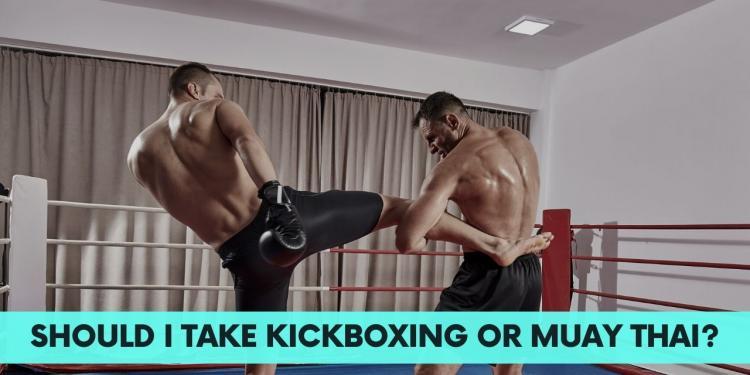Kickboxing and muay thai (MT) are great martial arts for developing vicious striking skills. Kickboxing is a striking style that incorporates and blends various martial arts like karate, boxing, muay thai, etc. Here we are going to describe the differences between Dutch kickboxing, which we simply refer to as kickboxing throughout this article, and muay thai to help you decipher the similarities and differences between them.
Background
The ruleset and culture of both combat sports have affected the progression and development of their fighting style. muay thai has mostly stuck to its traditional roots and still empower their fighters to strike with all parts of their limb: hands, elbows, knees, legs. Furthermore, attacks and takedown attempts occur frequently from the clinching position.
On the other hand, kickboxing rules prevent its fighters from integrating all aspects of muay thai. Popular kickboxing organizations (K-1, Glory and Bellator Kickboxing) has more striking options available than the original American Kickboxing rules that only allows punches and kicks above the waist. These organizations permit their fighters to throw low kicks and even knees. However, all three organizations’ format bans the use of elbows and considers takedown attempts a foul. In addition to that, each individual is only allowed to deliver a single strike from the clinching position.
Stance and Footwork
One of the first differences noticed by most observers is how muay thai and kickboxing contrast in their stance and movement.
Muay Thai
-
Striking Stance – In muay thai, fighters use a stance where their hips are completely squared to the opponent and they are standing with an upright posture. This stance has them placing their feet shoulder-width apart, and staggered in front and behind them. Within the stance, practitioners will distribute most of their weight to the rear leg. This action keeps their lead leg light for quickly throwing kicks and to block incoming low kicks with their shins.
-
Clinching Stance – Upon getting into clinching range, practitioners will utilize various hand positions for controlling the opponent’s head and upper body. Unlike their striking stance, they actually change their feet position to be horizontally in-line with each other and push their hips forward. This clinching stance provides the versatility of throwing strikes and taking the opponent down with various foot sweeps.
-
Rhythm – Traditionally, muay thai fighters move at a slower pace than kickboxers. They use a steady rhythm as they march towards their opponent. In Thailand, the matches are usually five rounds and the first round mainly consists of both fighters feeling each other out. The intensity and aggression between both competitors will pick up in the later rounds since the judges put a greater value on them.
-
Forward Movement – Due to Thailand’s cultural perception that fighters who use a lot of movements are dancing and avoiding the fight, muay thai fighters are not as shifty and mobile as kickboxers. Furthermore, it is almost sinful to use backward movements such as retreating from an opponent or if the fighters moves in and out of range too much. Muay thai has built a tough culture where some coaches will implement the “6th round” as punishment when they believe a fighter did not show enough heart in their match or the coaches notice fear and tentativeness from them. The 6th round is famous in Thailand for the additional sparring that the fighter has to go through when they get home after their match. Therefore, it is normal to see fighters constantly moving forward aggressively.
Kickboxing
-
Stance – Kickboxers use a stance that is a cross between a boxing and a muay thai stance. They have their legs staggered and hips turned away from the opponent. However, their hip position is not rotated as outward as boxing. The kickboxing stance reduces an individual’s centerline and opening for getting hit to the body. In addition to that, a kickboxer’s body weight is distributed evenly among both legs.
-
Footwork – Since the kickboxing community do not share the same feelings on how a fighter should move in the ring, you will observe kickboxers utilizing more explosive and dynamic footwork.
-
Pace – Kickboxers typically start out at a faster pace and they also maintain it throughout the fight, instead of having a noticeable escalation of intensity.
-
Blitzing – Kickboxers tend to be fighters that either like to use evasive movements or aggressively pressure their opponents. The former kickboxer types will use their footwork to rapidly get in and out of range at different angles.
Defense
The defensive styles of kickboxing and muay thai share many fundamental concepts, but they also have plenty of characteristics that distinguish them from one another.
|
Muay Thai Defense |
Kickboxing Defense |
|---|---|
|
Often reliant on long guard for punch and elbow defense |
Reliance on head movement or high guard to avoid punches |
|
In addition to using checks for kicks, they also work on kicking the planted leg of the opponent’s leg |
In addition to checking kicks, Dutch guys rely on footwork and movement to avoid damage to the leg |
Muay Thai
-
Long Guard – This Thai style guard creates a frame to defend against punches and elbows while also controlling your opponent’s distance. Unlike the standard boxing guard, this blocking technique is better at protecting you against elbow strikes that would normally split the guard or come over the top of it.
-
Signals – If the opponent is able to collapse a fighter’s long guard or bypass their lead arm, this action tells them that the opponent is within clinching and elbowing range.
-
Checking Kicks – The squared hips, knees turned outward and weight being distributed on the rear leg grants each practitioner the ability to instantly lift their lead leg and block low kicks with their shin.
-
Dodging and Leaning Back – As mentioned previously, fighters prefer not to retreat backwards to avoid a strike. Instead, they use their defensive guard, side-to-side movements and a leaning back motion to evade strikes. This tricky lean-back technique involves the practitioner taking a step backwards with their rear leg, leaning their head and upper body towards this leg and also guarding their face with the rear arm.
Kickboxing
-
Head Movement – Kickboxers rely on more head movements to avoid getting hit than muay thai fighters.
-
High Guard – The high guard is slightly different from the one employed in boxing. Rather than keeping your hands by your cheeks, the high guard requires you to raise both gloves to be above your eyebrows. Additionally, your elbows should be glued to your body.
-
Ear Muffs – Kickboxers like Glory’s heavyweight champion Rico Verhoeven will actually shift from this high guard to a defensive position where he covers his ears like “ear muffs.” He uses this technique to block and reduce the impact obtain during brawling exchanges where the opponent is repeatedly throwing powerful hook combinations. Of course, this is only a temporary defensive guard since it leaves you susceptible to straight punches and any other strike coming up the middle.
-
Dealing with Kicks – In addition to their adaptation of using muay thai’s kick checking technique, kickboxers also use their footwork and evasive movements to avoid the opponent’s kick altogether.
Offense
Even though muay thai techniques are commonly seen in kickboxing matches, kickboxing rulesets have resulted in the difference offensive emphasis below.
|
Muay Thai Offense |
Kickboxing Offense |
|---|---|
|
Muay thai guys are more reliant on kicks than hands |
Dutch guys spend a fair amount of time working on both the hands and the feet so they are adept at both |
|
Not known for long combos—rely on a precision |
Known for long combinations, and using the hands to set up the kick |
Muay Thai
-
Intent Behind Each Strike – Fighters tend to throw short combinations or singular shots where each strike is intended to land with maximum power.
-
Strike Selections – Since punching techniques score the least in muay thai competitions, preference is given to other striking options. In competition, a punch will not score as much as kick, unless the punch results in a knockout.
-
Clinching Options – Clinching is very important offensive position for all muay thai fighters where they can throw knees and elbows as well as take an opponent down.
-
Patience – Contrary to popular belief, fighters do not simply stand in place and swing away at each other. They are actually very patient in looking for openings and picking at their opponent. Once the later round occurs, this intensity elevates quickly and the fighters will release more powerful combinations.
Kickboxing
-
Punching – Due to limitations in clinching and elbows being illegal in competitions, kickboxers are more proficient at punching than muay thai fighters as a result of having a greater amount of time dedicated to this skill.
-
Striking Combinations – Kickboxers can be seen throwing long chain of combinations that flows between punching and kicking.
-
Setting Up Strikes with Quick Clinches – Major kickboxing organizations only allow their fighters to deliver a single strike before they are required to release their opponent from the clinch. Therefore, kickboxers will use a swift grab behind the head of the opponent and pull them into an uppercut or a rising knee.
Conclusion
This article provides a quick glimpse into the world of two dynamic combat sports. The rulesets within each sport will invariably create a slightly different curriculum. However, modern day gyms have enough cross-pollination from different sports that can blend both martial arts together into a seamless program.
Each has their own benefits and are great choices for self defense. The comments noted above are general observations and not absolute statements for all individuals within these combat sports. Based on your personal preference, which striking style seems more appealing to you?





